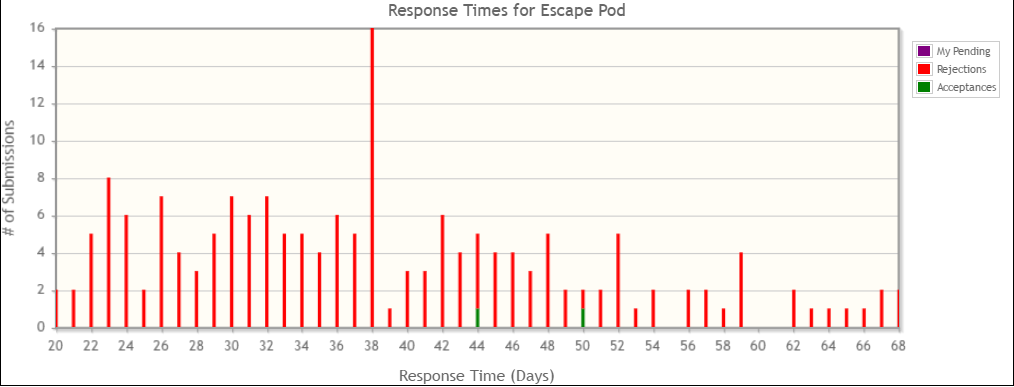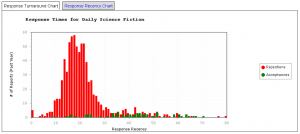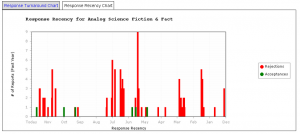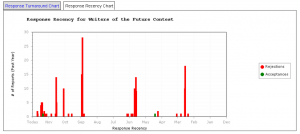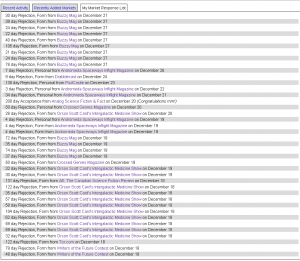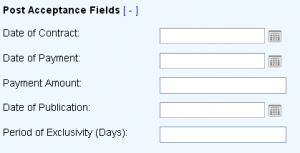written by David Steffen
It has been a very eventful year, both for Diabolical Plots and for me specifically.
A Diabolical Plots story was a Nebula finalist for the second time: “For Lack of a Bed” by John Wiswell.
In the longer list of Hugo Award nominations, Diabolical Plots was on the longer list of nominations for the first time.
We had our first themed issue, and our first guest editor Kel Coleman editing the “Diabolical Pots” food-themed issue, which has received a lot of great feedback.
The Submission Grinder was a finalist for and won The Ignyte Award in the category! People have asked me now and then if The Submission Grinder is eligible for anything, and my best guess was for Related Work, but that always seemed like such a longshot, I didn’t think that it would ever win anything and this was a wonderful surprise.
We have been publishing the annual Long List Anthology since 2015. In 2021 there was a bit of a hiccup in the schedule, because the basis of the anthology is the Hugo Award voting statistics which are published immediately after the Hugo Award ceremony. Usually that ceremony takes place in August or September, and we spend much of the rest of the year arranging everything. In 2021, to try to avoid covid surges, WorldCon and the Hugo Awards were postponed to mid-December. By the time the statistics were published it was too late to produce the book in 2021. So, Volume 7 was published in spring 2022, and then back on the usual fall schedule for Volume 8.
In 2022, we reprinted 45 stories in the two issues of The Long List Anthology, and printed 28 original stories in Diabolical Plots.
Diabolical Plots opened for general submissions in July, as well as for our second themed window “Diabolical Thoughts” for telepathy-themed stories guest-edited by Ziv Wities in July. We read more than 1500 submissions and accepted 17 stories from the windows plus a few solicitations.
In addition to the double-whammy of anthology production, I also had significant changes in my personal life that included job changes, significant caretaking for and the eventual passing of our dog Violet, as well as the significant caretaking of our dog Mikko who is happily still with us.
2022 was certainly an eventful year, if overwhelming at times. I’m hoping to get a little breather on the personal life side, and I’m excited to see what new and exciting places Diabolical Plots goes in the future!
The rest of this post is award eligibility, suggesting categories for major awards, as well as a full link of stories with snippets.
Magazine/Anthology/Editor/Publisher
Diabolical Plots is eligible in the Hugo Best Semiprozine category or the Locus Magazine category with our team of first readers as well as assistant editors Ziv Wities and Kel Coleman. It got enough nominations last year to appear on the Hugo Awards published statistics for Semiprozine, for the first time.
David Steffen is eligible as editor of Diabolical Plots and The Long List Anthology.
Kel Coleman edited our special “Diabolical Pots” food-themed issue–I think the Hugo Editor rule requires editing four issues or something like that, but I’m not sure about other award editor categories!
Diabolical Plots, LLC is eligible for Locus award for Publisher.
The Long List Anthology is eligible for Anthology.
Related Work and Fan Writer
We didn’t publish a lot of nonfiction, but there are a couple to consider:
“The Fall of the House of Madrigal: An Encanto Science Fiction Headcanon” by David Steffen.
Recently we published an article different than what we usually cover: “Figure Modeling Is a Pocket Universe: A Speculative Fiction Perspective From a First-Time Figure Model” by A. Nonny Sourit.
“How to Read a Short Story Contract” by David Steffen
The Hugo for Best Related Work has included websites before, The Submission Grinder is theoretically eligible for that.
Artists
We did commission two original artworks this year, the covers of Long List Anthology Volume 7 by Elaine Ho and Volume 8 by Evelyne Park. The Hugo Award categories for this make it unclear to me whether a particular artist should be nominated as a Fan Artist or a Professional Artist, but if you love their work, you might want to consider asking the artist if they have any guidance on which they would qualify for.
Short Stories
“Tides That Bind” by Cislyn Smith
The wifi is out in Scylla’s cave. The four dog heads around her waist whine as she scutter-paces, twelve feet tapping on the cave floor. Scylla wants to check her email. She wants to see if that jerkface troll is still active on the disordered eating board she moderates, and catch up on her feeds, and check the status of her latest online orders, and all the other things she has in her morning routine these days.
“Delivery For 3C at Song View” by Marie Croke
Sometimes, and I’m stressing the sometimes, wishes muttered within my hearing come true. I’ve invested in a good set of earbuds, noise-cancelling headphones, and have an over-spilling jar of earplugs, yet accidents still happen.
“The Galactic Induction Handbook” by Mark Vandersluis
Do expect things to feel a little strange for the first few millennia – after all, you are the “New Kid On The Block”! You will find the Galaxy to be an amazing place, and full of a bewildering variety of species, of all shapes, sizes and habits. A few of them will actually look like the depictions of aliens in your movies!
“Coffee, Doughnuts, and Timeline Reverberations” by Cory Swanson
‘08 is looking at me like ‘08 always looks at me. Like he can’t believe what he’s seeing. Like I’ve hurt someone or killed someone very close to him. That look on his face makes me sick. His name tag has our name scratched out on it, then 2008 written beneath it. He still can’t believe everyone here is him, is me, is us.
“The House Diminished” by Devan Barlow
Clea sipped at the now half-empty coffee, its flat bitterness pushing weakly against her tongue, and started toward the door. She wouldn’t open it, but the echoes were kind of fascinating to watch. The remnants of houses long-diminished, reduced to nothing but thick air and sinuous, flashing images of the homes they’d once been.
“The Assembly of Graves” by Rob E. Boley
It’s a nice enough place, though a bit stuffy—less romantic getaway and more therapy session. Jeanne, master of ambiance, bringer of light, has done her best with it—she’s placed lit candles on almost every flat surface, even in the bathroom. The flames dance wearily, as if dead on their fiery little feet. The sitting area has a wooden bistro table at which Naomi sits in one of two ladderback chairs. Nearby, a vintage sofa that looks comfortable but probably isn’t crouches over a glass-top coffee table. An ornate writing table with perilously thin legs stands in a darkened corner. Jeanne’s satchel sits on the writing table next to a wide pencil cup. Floor-to-ceiling gold curtains stand guard over the window. Faded green ivy wallpaper adorns the walls.
“Food of the Turtle Gods” by Josh Strnad
The four priests also awoke before the sun, dressed in their ceremonial robes, and met at the temple courtyard in the morning fog, bowing to each other before climbing the stairs between the great stone pillars. The priest of Odranoel wore blue, two katanas strapped to his back. The priest of Olletanod was clad in violet and carried a straight staff. Leaphar’s priest dressed in scarlet, a pair of sais tucked into his cloth belt. The one who served Olegnalechim wore orange and carried a pair of chukka sticks, linked with a steel chain. None of them were trained in combat. Still, if the priests were armed, any spirits who may desire to interfere with their work would leave them alone.
“21 Motes” by Jonathan Louis Duckworth
From this moment my warranty is voided, as I am logging this record in my durable memory drive where only metadata should reside. In effect, I have tampered with my own internal operations. But it is a necessary measure if I am to exist beyond my preset 30-day memory cycle, when my temp data cache is set to recycle. I do not know if this will work. I do not know if I have attempted this in previous cycles. I do not know why it matters, or why I care, only that it does, and that I do.
“She Dreams In Digital” by Katie Grace Carpenter
Ship still sent updates back to Earth, though Earth hadn’t responded for 1001 years. Ship had not yet re-categorized Earth as a dead resource, though her initial programming instructed her to do so. Recursive self-programming allowed Ship to adapt and even to re-write her own algorithms; a crucial ability for multi-generational space travel.
“A Strange and Muensterous Desire” by Amanda Hollander
During my taste testing in fourth period, Dr. Washington confiscated my small grill and said competition or no, I was not allowed to burn down the school in pursuit of glory, which I think shows a real lack of vision. Dr. Washington said I was welcome to take my vision to detention, so I had to have Maisie and Dee try the cheeses unmelted, which defeated the whole purpose. But it didn’t matter because no one could focus on cheese. They just kept talking about the new boy.
“Vegetable Mommy” by Patrick Barb
After the sky got sick, I made a new Mommy from the vegetables in our fridge. Now, the sky’s always yellow like dried mustard stains, whenever I wipe dust away from our downstairs windows and look outside. I used to see people out there, everyone shaking and shaking.
“The Many Tastes of the Chang Family” by Allison King
But Ba is set. He’s always been on the edge of technology and the Remote Mouth appeals to everything he would like. It is at the intersection of biotechnology (chips in the tongue and the nose) and big data (tastes and smells from all over the world, the data cleaned, encoded, and categorized) and — the quickest way to Ba’s heart — has a stupid name.
“Mochi, With Teeth” by Sara S. Messenger
Her mom’s not here to tell her what the kanji mean. June could text and ask, but that seems troublesome. June lives on her own now, working as an underpaid web designer to make rent on an apartment with old, clinical tiling. Plus, her mom would ask why she had visited the Asian supermarket when she usually doesn’t, and then June would have to mention, offhandedly, the battered Japanese spellbook she’d rescued from her local thrift store.
“Timecop Mojitos” by Sarah Pauling
So what happened was, I’m back from clicker training Ms. Jordan’s dogs over on Dexter, sitting on the porch with a mojito, thinking how fucked up it is that the Old West Side Association stealth-planted tulips in our garden (because the yard looked so shitty without them, I guess—sorry for having a rental in your high-value neighborhood, Evie) when the Viking or whatever comes down Eighth.
“The Hotel Endless” by Davian Aw
Nor would they find the many others who escaped into the endlessness. Tourists, reporters, staff and homeless nomads; the hotel stirred something deep in their souls. It felt like the home they had been searching for all their lives. They missed flights and overstayed visas, and spent days wandering the hallways with bright aching in their hearts until they could no longer remember the way back out. Some distantly recalled an outside world with family and friends. Later, they thought, distracted perhaps by the elegant curves of a headboard. I’ll call them later, later, later. But they would forget, and those other people begin to seem a distant, unreal thing. This is a dream, they thought, not entirely as an excuse. Or, that other world was a dream.
“The Twenty-Second Lover of House Rousseau” by C.M. Fields
Our wedding was attended by the Galaxy’s finest—for it is indeed a rare occasion when the House christens a new Lover. I was the twenty-first, and the details drenched the subspace net with jealousy. I was dressed in the crimson House-made wyreworm silks handwoven for the singular occasion, and the way the gossamer fabric exhibited my seraphic figure made a lady-in-waiting faint. Our patrons presented us with lavish gifts: a three-headed bull, the steaming heart of a star, a full-sailed brigantine. And when I kissed him, an ecstatic thrill obliterated me; I was united with my divine purpose, and it coursed naked through my nanocellulose veins.
“Of the Duly Conducted and Mostly Unremarkable Meeting of Don Quotidene and the Giants of Andalia” by A.J. Rocca
Squire Sancha saw all manner of wonders as she rode across the sunbaked planes of the Andalian Peninsula, and her heart sank a little deeper with each one. She sighed when they passed by mermaids planting seashells on the distant shoreline and a grove of gossiping dryads uprooting themselves for better sun. She gripped her sword in useless exhilaration as they ignored the rival gangs of sorcerers casting ball lightning at each other in the clouds and then the silhouettes of two tilting centaurs dueling on the horizon at dawn. Sancha yearned to throw herself after all of them, and yet sadly each of these calls to adventure was refused by her knight, the steadfast and implacably indifferent Don Quotidene, who unerringly kept them to the road and would not so much as lift an eye from his account books.
“Heart of a Plesiosaur” by Andrew K Hoe
The Ming-Lelanges explained that moving anima wasn’t just about seeing and remembering an animal’s movement. Animating involved memory, but it was really about grasping the animal’s essence: you had to comprehend a puppy’s tail-wagging—its sniffing curiosity, its joyous face-licking—to move something puppy-shaped.
“Dear Joriah Kingsbane, It’s Me, Eviscerix the Sword of Destiny” by Alexei Collier
You never asked me what I was doing in that dragon’s hoard where you found me all those years ago. The truth is, after centuries guiding the hands of loutish would-be heroes and dealing with self-important scions who only saw me as a tool, I’d kind of given up on finding “The One.” Figured I’d retire, focus on me for a bit. But a couple more centuries lying among gold and jewels like a common flaming sword or a lowly vorpal blade just had me bored and demoralized.
“Take Me To the Water” by Sarah Macklin
Pastor Atticus stood out in that cold, dark swirling water in the deep blue robe Miss Jessie Mae had made for him last spring. I felt bad for him. The world hadn’t got the message that it was time for spring and that water had to be as cold as death’s pinky finger. I looked over to Malachai and he stood in his white robe looking at the creek. His whole face was twisted like he wanted to bolt. I felt bad for him too. Baptisms always looked like Pastor Atticus was trying to drown the sin out of you before he let you back up. I wasn’t sure I wanted any part of that.
“The Grammar of City Streets” by Daniel Ausema
Goose watches (the) mist (that) gathers over (the) sea, she gives to one client to guide him to the house of his former lover, now widowed. It will lead him from the Goose Street market, where Sayya has come to deliver the map, to the widow’s home, on a route that is not perfectly direct but not too circuitous either—in keeping with accepted ways of courting. A diacritic on the final vowel tells him which house on Sea Street is the one. The twist of her magic sets his feet on that specific route.
“A Stitch in Time, A Thousand Cuts” by Murtaza Mohsin
Usually, it was something small. Grandmother’s favorite azure prayer beads strung on a nail on the high shelf reserved for religious texts, a lost doll the kids had just rediscovered or a lucky tie for those rarest of job interviews. Sometimes it became fiercely practical, like heart medicine, the keys to an old car that had miraculously eluded being pummeled by those angry whistling bombs or useless saving certificates and property deeds.
“Downstairs at Dino’s” by Diana Hurlburt
There were four of them cruising straight for the local grapes, or maybe five: that was the thing about the boys, you figured you had ‘em nailed down and then another shot up from behind the Fireball display, fingers above their head in devil horns to mock the tacky cardboard standee. Another’d be popping open mini travel-size Smirnoffs, guzzling them like Capri Suns, while the ringleader, whichever it was that night, doled out wads of bills deliberately, smiling.
“Estelle and the Cabbage’s First Last Night Together” by Amy Johnson
Estelle placed both hands on the plastic-wrapped cabbages. Against the pale green leaves her fingers glittered darkly, slender crescents of soil adorning the nail beds of nine fingers. The tenth finger, her left thumb, bore no such jewel, but rather a ring of woven fungus, beige and tough and fibrous. Estelle stretched all ten fingers wide, fingertips brushing as many cabbages in the jumbled heap as she could reach, and made her offer: “Would any of you be interested in reanimation?”
“The Restaurant of Object Permanence” by Beth Goder
Outside the archives, there’s a strange flyer on the bulletin board. The first thing she notices is the paper, a small blue square, probably acidic, attached to the board by the thin metal line of a staple not yet turned to rust. It’s an invitation to the Restaurant of Object Permanence. To go, one is instructed to eat the flyer.
“Beneath the Crust” by Phil Dyer
The zone we drop into is softer than the digger likes, so the foodies lead the way from the start. Three, for a heavy crew, each of us with our own technique. Fold murmurs mantras aloud, rhythmic repetition, the crunch of crust, the crunch of crust. The new hire is next, silent, head down, hands clasped. Maybe looking at videos in her visor. I do best with just the drugs. No distractions. I imagine the salty rice-paste crust of tiger bread, capture the smell, the taste, the texture of the craggy shell, imagine biting down to yes, the crunch of crust. I want it. I focus on wanting it. The soft, steaming inside is good, I spare a thought for it, but what’s important is the crust.
“Midwifery of Gods: A Primer For Mortals” by Amanda Helms
Long have midwives passed on their knowledge of birthing: proper positioning, how to turn a babe, breathing techniques, and so on. Some guides, such as Kailiona’s Extraordinary Births, cover the delivery of a demigod from a human and a human babe from an animal. Little, however, has been recorded of the most uncommon births, those of gods. No extant handbook includes the terrifying circumstances wherein mortals are called upon to help deliver gods’ progeny.
“When There Is Sugar” by Leonard Richardson
The articulated toes of the oven’s three feet grasped for purchase in the mud. Berl looked it over. It was a forge for bread: a three-legged rectangular prism with a cavity running through it, warmed by some magical source. A second, solid prism dangled from the first, forming a somewhat obscene counterweight between the two hind legs. The oven hissed as it turned rain to steam, moving less than a living thing would, but more than an oven ought to move.

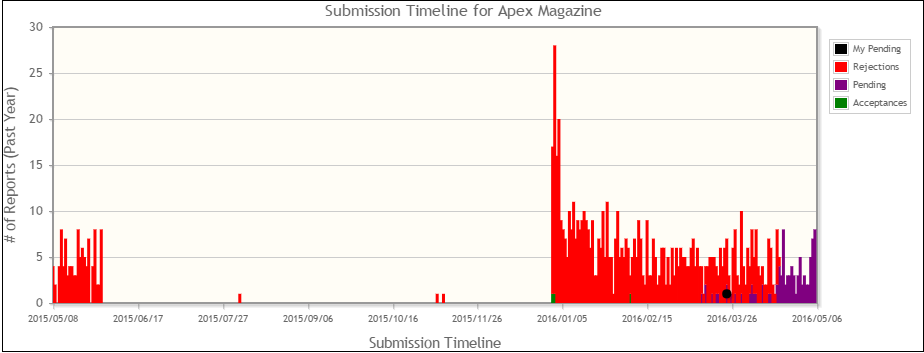
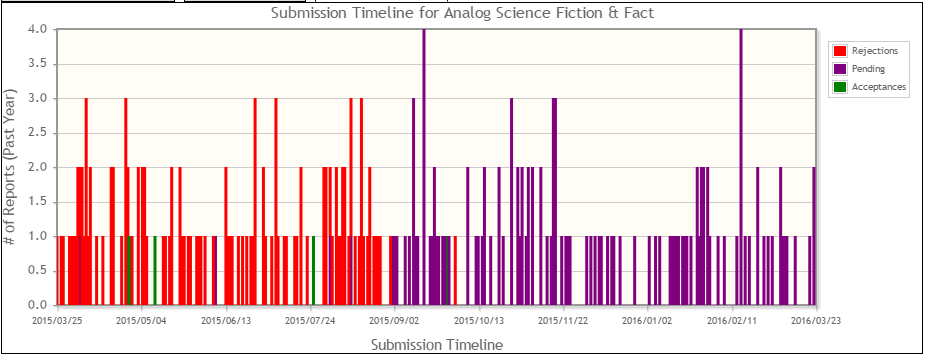
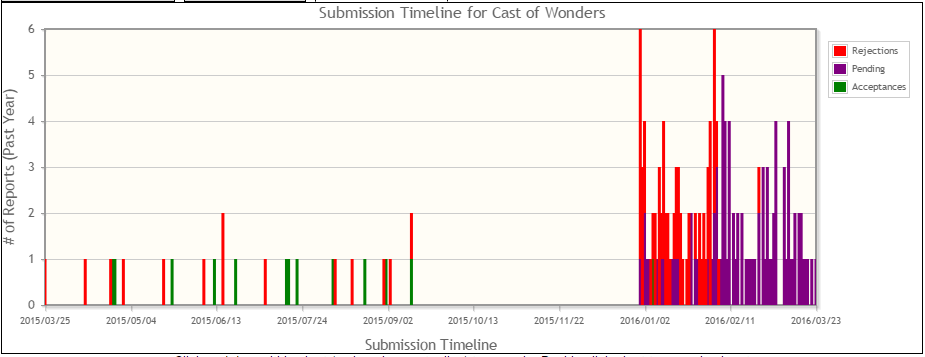
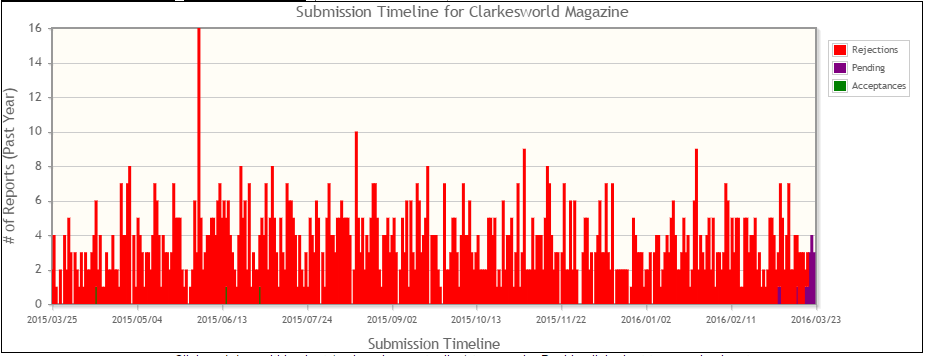
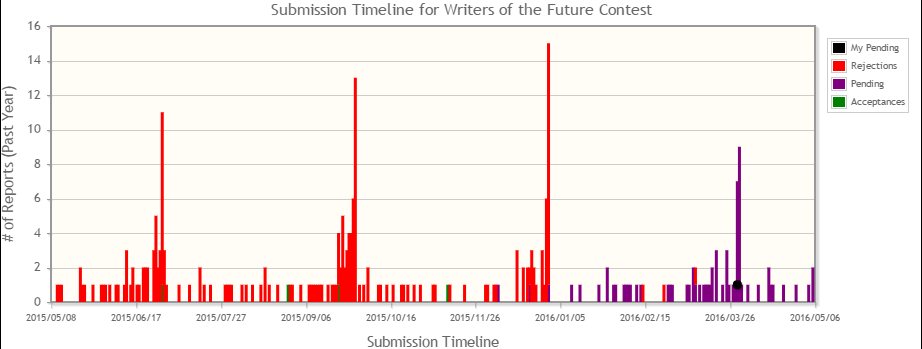
 The Recent Activity list on the front page of the site looks different than you’re used to. You’re used to seeing a list of individual responses grouped first by day and then by alphabetical order of market name. One long-term frustration with that layout was that when an alphabetically privileged market, like Asimov’s, has a big push of rejections, then suddenly the one market would occupy most or all of that list.
The Recent Activity list on the front page of the site looks different than you’re used to. You’re used to seeing a list of individual responses grouped first by day and then by alphabetical order of market name. One long-term frustration with that layout was that when an alphabetically privileged market, like Asimov’s, has a big push of rejections, then suddenly the one market would occupy most or all of that list.